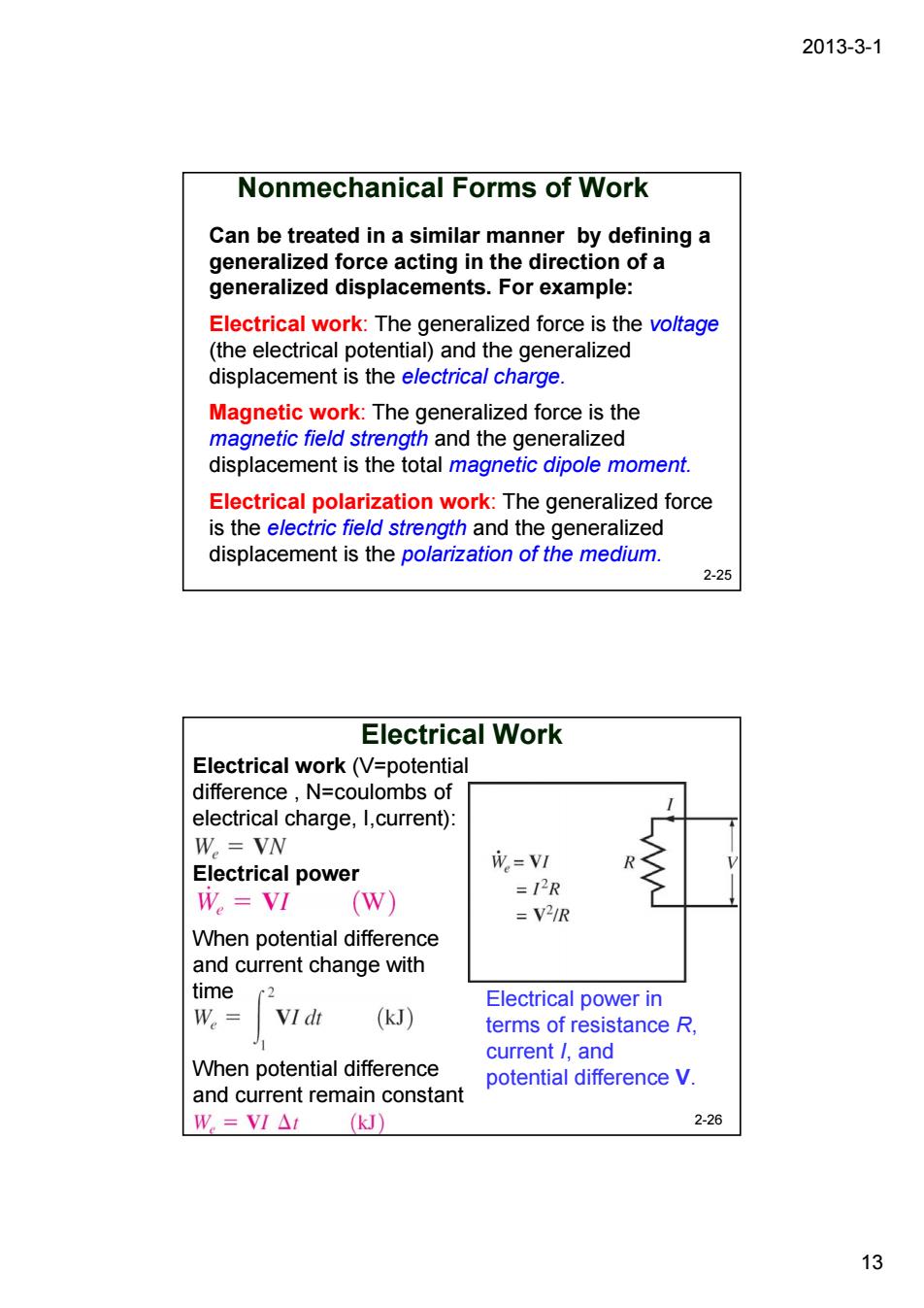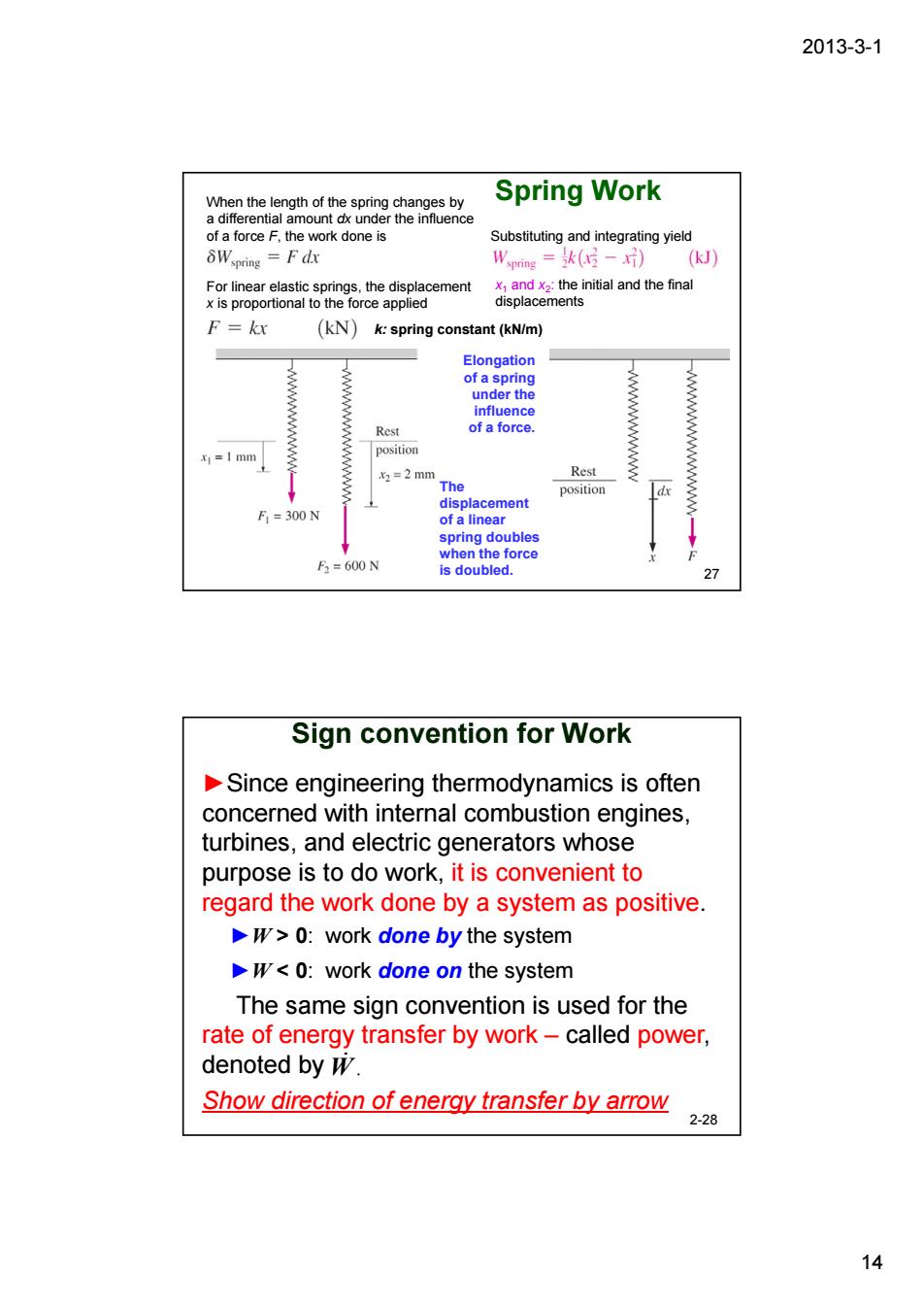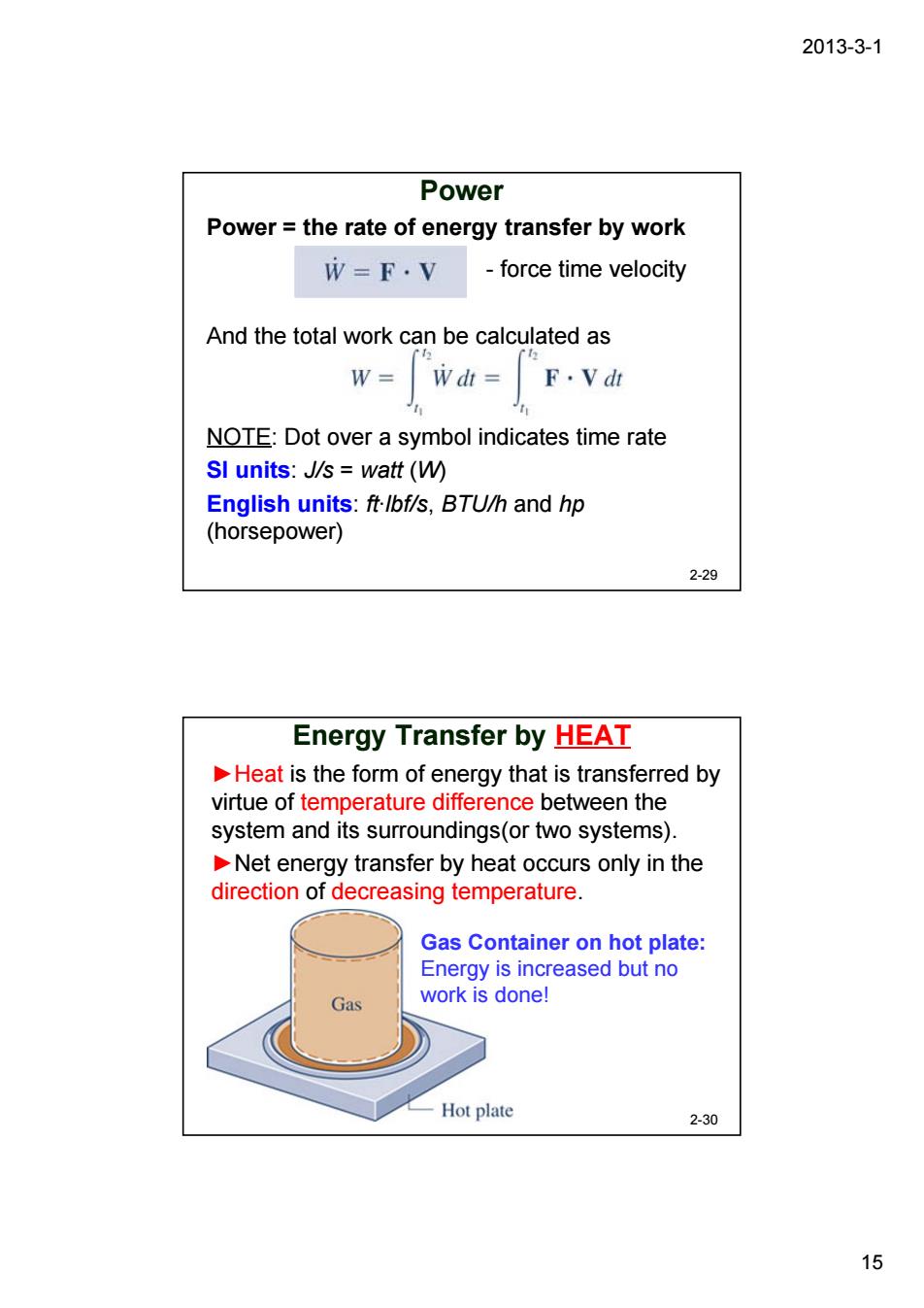
2013-3-1 Quasiequilibrium Process “ Boundary Pressure-volume data in an actual expansion A quasiequilibrium process is one which the departure from thermodynamic equilibrium is at most infinitesimal. 2-23 Example 2.1 A gas in a piston-cylinder assembly undergoes an expansion process for which the relationship between pressure and volume is given by pV"=constant The initial pressure is 3 bar,the initial volume is 0.1m3.Determine the work for the process,in kJ,if (a)n=1.5,(b)n=1.0,(c)n=0. 2-24 12
2013-3-1 12 Quasiequilibrium Process 2-23 A quasiequilibrium process is one which the departure from thermodynamic equilibrium is at most infinitesimal. Pressure-volume data in an actual expansion Example 2.1 2-24 A gas in a piston-cylinder assembly undergoes an expansion process for which the relationship between pressure and volume is given by The initial pressure is 3 bar , the initial volume is 0.1m3. Determine the work for the process, in kJ, if (a)n=1.5,(b) n=1.0,(c) n=0. n pV constant =

2013-3-1 Nonmechanical Forms of Work Can be treated in a similar manner by defining a generalized force acting in the direction of a generalized displacements.For example: Electrical work:The generalized force is the vo/tage (the electrical potential)and the generalized displacement is the electrical charge. Magnetic work:The generalized force is the magnetic field strength and the generalized displacement is the total magnetic dipole moment. Electrical polarization work:The generalized force is the electric field strength and the generalized displacement is the polarization of the medium. 2-25 Electrical Work Electrical work(V=potential difference,N=coulombs of electrical charge,I,current): W.=VN Electrical power 成=VI W。=V (W) =12R =V21R When potential difference and current change with time Electrical power in W.= (kJ) terms of resistance R, When potential difference current /and potential difference V. and current remain constant W=VI△(kJ) 2-26 13
2013-3-1 13 Can be treated in a similar manner by defining a generalized force acting in the direction of a generalized displacements. For example: Electrical work: The generalized force is the voltage (the electrical potential) and the generalized displacement is the electrical charge. Magnetic work: The generalized force is the magnetic field strength and the generalized displacement is the total magnetic dipole moment. Electrical polarization work: The generalized force is the electric field strength and the generalized displacement is the polarization of the medium. 2-25 Nonmechanical Forms of Work 2-26 Electrical Work Electrical power in terms of resistance R, current I, and potential difference V. Electrical work (V=potential difference , N=coulombs of electrical charge, I,current): Electrical power When potential difference and current change with time When potential difference and current remain constant

2013-3-1 Spring Work Substituting and integrating yield 6Wsping =F dx Wspring=)(kJ) sp6esanesnialandnefnai F=kx (kN)k:spring constant (kN/m) Elor ofa spring 2 mr position rce 600N is doubled Sign convention for Work Since engineering thermodynamics is often concerned with internal combustion engines, turbines,and electric generators whose purpose is to do work,it is convenient to regard the work done by a system as positive. >0:work done by the system <0:work done on the system The same sign convention is used for the rate of energy transfer by work-called power, denoted by w. Show direction of energy transfer by arrow 2-28 14
2013-3-1 14 27 Spring Work Elongation of a spring under the influence of a force. When the length of the spring changes by a differential amount dx under the influence of a force F, the work done is For linear elastic springs, the displacement x is proportional to the force applied k: spring constant (kN/m) Substituting and integrating yield x1 and x2: the initial and the final displacements The displacement of a linear spring doubles when the force is doubled. Sign convention for Work ►Since engineering thermodynamics is often concerned with internal combustion engines, turbines, and electric generators whose purpose is to do work, it is convenient to regard the work done by a system as positive. ►W > 0: work done by the system ►W < 0: work done on the system The same sign convention is used for the rate of energy transfer by work – called power, denoted by Show direction of energy transfer by arrow W. & 2-28

2013-3-1 Power Power the rate of energy transfer by work W=F.V -force time velocity And the total work can be calculated as W=wdt= F.Vdt NOTE:Dot over a symbol indicates time rate SI units:J/s watt (W) English units:ft-Ibf/s,BTU/h and hp (horsepower) 2-29 Energy Transfer by HEAT Heat is the form of energy that is transferred by virtue of temperature difference between the system and its surroundings(or two systems). Net energy transfer by heat occurs only in the direction of decreasing temperature. Gas Container on hot plate: Energy is increased but no Gas work is done! Hot plate 2-30 15
2013-3-1 15 Power 2-29 Power = the rate of energy transfer by work - force time velocity And the total work can be calculated as NOTE: Dot over a symbol indicates time rate SI units: J/s = watt (W) English units: ft·lbf/s, BTU/h and hp (horsepower) Energy Transfer by HEAT 2-30 ►Heat is the form of energy that is transferred by virtue of temperature difference between the system and its surroundings(or two systems). ►Net energy transfer by heat occurs only in the direction of decreasing temperature. Gas Container on hot plate: Energy is increased but no work is done!